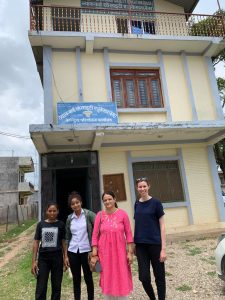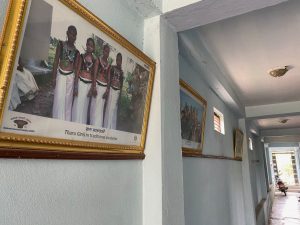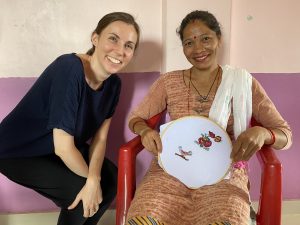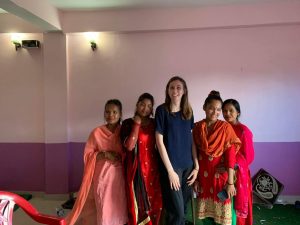I have been thinking about theories of change recently. Individuals have them and so do organizations. These theories guide our problem solving and refine the lens through which we see an issue. What started out as a seemingly straightforward intention between two partner organizations to work on a project together that addresses labor rights violations, ended up being an interesting dive into how theories of change can make things more complicated than intended.
BASE as an organization has a long history of fighting unjust labor practices in Nepal. First formed in 1985 and incorporated in 1990, the group helped organize a non-violent movement against traditional systems of bonded labor particularly practiced in the western Terai regions of Nepal.
The Kamaiya system of bonded labor required people without land to take loans from landowners to allow them to cultivate some of the landowner’s land for their own basic subsistence. Landowners would raise loans to such exorbitant debts that whole families were trapped into selling their labor in exchange for subsistance land access and thus living and working on the landowner’s land in what amounted to slave labor. Families could get stuck in these bonds of indebtedness for years or generations.
Through BASE and other partners’ efforts, the Kamaiya bonded labor system was officially abolished in 2000. The organization continued to fight against the system’s informal continuation and they became a social services provider to rural and marginalized communities, especially for ex-bonded laborers.
The next big fight against bonded labor came in the form of the Kamlari system where girls and young women were sold into indentured servitude under contract to work as domestic workers in rich and high-caste households.
The government affirmed in 2006 that the practice was illegal, but it wasn’t until 2009 that freed kamlaris began receiving financial support, greater access to education, and rehabilitation. And it wasn’t until 2013 that the Kamlari system was officially abolished. As with the Kamaiya system, BASE continues to fight against the informal perpetuation of bonded labor and support the needs of ex-bonded laborers. Today, BASE is continues to work towards a society that respects the labor rights and human dignity of all peoples.
From my own observation it seems to me that with time it gets more difficult to dissociate campaigns for human rights and campaigns against poverty; a distinction which may have always been arbitrary but at least helpful in organizing campaign action items.
For example, we talked with BASE about issues of child labor at a nearby brick kiln where workers will travel from out of town during the peek labor season to work there. As children accompany their parents and move away from their hometown, they end up missing school and working in the kilns alongside their parents.
Based one one’s theory of change, an organization trying to address this challenge could suggest many different kinds of interventions such as using legal means, providing alternative educational opportunities, or advocating for a social norms shift. But ultimately, the root cause is still poverty.
The other important note to remember is not all forms of labor are created equal. There is a huge distinction between the case of child labor at the brick kiln, for example, or the bonded labor of the Kamaiya and Kamlari systems that are so unsavory to human rights and dignity that they deserve wholesale eradication versus just labor systems that honor the dignity of workers.
For example, a system that respects labor rights and that compensates housekeeping or domestic work with proper financial remuneration cannot be eradicated on the basis that domestic workers would rather work another job instead. A demand for domestic work such as dishwashing, laundry, cleaning, etc. will continue so any focus on this line of work must also include working towards the proper application of labor rights.
A lingering thought I’ve had on this subject is how in working towards a system of labor that ensures workers are protected against various abuses and improper work conditions, the historical legacy of egregiously unequal power relations in society makes this all the more complicated.
If the worker’s and employer’s social group affiliation have not changed with time, how do you ensure that old patterns of inequality are not perpetuated? Does it become harder to measure what proper labor relations that respect labor rights look like if entrenched power dynamics have not shifted since before the abolishment of bonded labor, for example? I’m no expert in these issue areas, but I do think spending time in Dang, with BASE and at the embroidery training, I’m growing much more aware of how thorny everything can be.
In 2019, BASE was looking to wade into this prickly topic by focusing on women who work informally as dishwashers mostly for household employers, but also for hotels or at one-off events. The project was delayed by COVID-19 which, of course, changed workforce patterns around the world. 2022 looks a little different than 2019. Demand for housekeeping work dropped during pandemic lockdowns, and certain women’s life situations changed in the past couple of years as well.
For example, some of the women we spoke to at the embroidery training used to take on dishwashing jobs, but now they have a young child at home. Or another woman who used to work as a dishwasher recently opened her own small grocery store from her house. Different adaptations have been made.
On the other hand, women shared that they were not currently working dishwashing or housekeeping jobs, but anticipated returning to the work once they could as they didn’t see an alternative for themselves. Someone else shared that since she got married, she took over her mother-in-law’s job working for a household doing their dishes and other domestic tasks.
Lots of the challenges facing women who take on these jobs seem somewhat universal to many wage labor workers. These gigs are under the table and informal meaning pay is not consistent. And with informality there is no accountability mechanism for potential labor abuses or legal recourse for not abiding by labor laws.
The participants in the training all described the composition of their household income. The range in each woman’s experience stemmed from complete self-reliance on subsistence farming on your own land, to share cropping, to complete dependence on wage labor from all adult household members. Most commonly, households were in some mix between agricultural and wage work (including wage labor outside the country that returned to the household as remittances).
The women at the training are pulled in many directions, and while it seemed easy to use one identifier of “women who work as dishwashers,” in fact women are juggling multiple paid and unpaid work streams and entering in and out of certain job classifications. But a common thread amongst the women who currently work, previously worked, or anticipate working in dishwashing is their disinterest in the work itself. They want to be doing something else.
This demand has informed how BASE offers their programming as a big focus of theirs is on reskilling and continued education. I think the situation is challenging, but while one woman’s circumstances might improve, I worry about the next woman who will take the job she leaves behind. Is it possible to lean into two separate theories of change at once – one that finds alternative employment and one that improves the status of the current line of work?
I think part of that answer will come with time from the women themselves. Embroidery trainings are a lesson in a new skill set, yes, but more than that they are meant to function as, one, an opportunity to build community and solidarity amongst a group of participants and, two, to acclimate participants towards growing one’s voice through visual storytelling first and public engagement second.
Based on the experience of working with BASE, it seems that open discourse on labor practices amongst this group of women may be the most challenging first step as domestic work is looked down upon and there’s social stigma to identifying oneself with the work. There are a lot of potential next steps in the labor rights journey for this group of women, and I hope that speaking out about their experiences, perhaps amongst themselves in these initial stages, brings greater momentum to engaging in greater public discourse on these issues.
I know I’ll miss spending those training day with ladies like my miniti. As the two tallest women in the room, it was decided that Rukumi and I are bonded in a miteri friendship, like a kindred spirit or friend turned sister kind of relationship.
And of course, I can’t forget my Tik Tok director and co-stars.
I have a lot of confidence in the team from the training and hope I can follow the group’s progress over time.
Posted By Therese McCarry
Posted Jul 9th, 2022






2 Comments
Iain Guest
July 12, 2022
Fascinating, deep and very thoughtful post! Let me pick up some of the most interesting and challenging idea starting with a) the root cause of these labor practices, which you describe very well. Bonded labor – kamaiya – was the product of a system that was patently unjust, easy to identify and relatively easy to address (through laws). b) The problem of dishwashers is clearly much more complex and appears to have shifted as a result of the pandemic. From wh at you write the situation of each woman is very different and this makes it harder to produce a change. c) Poverty and human rights – poverty is at the heart of all of this, isn’t it – but poverty is about the lack of options and choices as much as money. (But – be careful about separating human rights and poverty – many consider poverty to be a clear violation of rights! d) the contribution made by embroidery. You explain this really well! Makes me think that you, BASE and your embroidery trainers were making a very important contribution with your Dang training.
Daniel Gurevitch
July 12, 2022
Really interesting blog and a great way to understand more about your field work! I was really struck when you wrote that “I worry about the next woman who will take the job she leaves behind. Is it possible to lean into two separate theories of change at once – one that finds alternative employment and one that improves the status of the current line of work?” I think that this is a question we often overlook — in helping one group might we be ignoring another? Difficult questions to answer but I think you’re on your way to figuring them out for yourself!